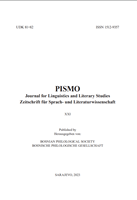Hipermodernističke karakteristike djela Gomorra Roberta Saviana
Hypermodernist Characteristics of Robert Saviano’s Novel Gomorra
Author(s): Mirza MejdanijaSubject(s): Theory of Literature, Italian literature, Sociology of Literature
Published by: Bosansko filološko društvo
Keywords: hypermodernism; realism; chronicle; literature; mafia;
Summary/Abstract: Literary critics most often mention the year 1995 as the end of postmodernism in Italian literature. The new literary current that appears then is called the hypermodern. In this new phase, history is moving, conflicts are manifesting again, the discord between intellectual life and the political-economic order is productive again. The hypermodern abandons the modernist belief in progress because it does not essentially believe in its promises of happiness. Therefore, it is the answer and partly a melancholic consequence of the postmodern, because by celebrating its characteristics, it colors them with darkness. What has primarily changed is the position of the intellectual who writes and who speaks about the present, as a result of which the choice of the topics changes significantly. One of the first changes that appears is the influx of chronicles, which bring with them a division within literature into true and false events. On the one hand, prose approaches journalistic reporting, between documentation and accusation. On the other hand, these works represent a true testimony, using an autobiography or a credible first-person story. Gomorra is the debut novel by Napolitan writer Robert Saviano, and represents a journey into the economic empire and social domination of the Camorra, a Napolitan mafia organization. When writing, Saviano uses a mixture of chronicle and literature, real and unreal in one pronounced confusion. As a result, literary critics have debated whether this is a novel or not. But in Gomorra, the heat of truthfulness and social engagement does not correspond to the same amount of documentary accuracy. The work is rather reluctant to cite its own sources and show journalistic materials, it does not cite statements, interviews or wiretaps. The reconstruction of the event is all entrusted to the narrator, who thus takes responsibility for everything he claims. Saviano does not cite journalistic articles, he transcribes them, thus turning information and testimonies into a story. Gomorra represents a crossroad in the history of Italian literature, as it changes the relationship between journalism and literature, which is now becoming a high-risk activity. Saviano actually presents his truth in a hypermodernist way.
Journal: Pismo - Časopis za jezik i književnost
- Issue Year: 2023
- Issue No: 21
- Page Range: 259-275
- Page Count: 17
- Language: Bosnian

